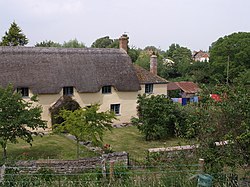Athelney
| Athelney | |
| Somerset | |
|---|---|
 Curload Farmnear Athelney | |
| Location | |
| Grid reference: | ST348288 |
| Location: | 51°3’20"N, 2°55’52"W |
| Data | |
| Post town: | Bridgwater |
| Postcode: | TA6 |
| Dialling code: | 01278 |
| Local Government | |
| Council: | Sedgemoor |
| Parliamentary constituency: |
Bridgwater & W. Somerset |
Athelney is a hamlet and area of the Somerset Levels between the villages of Burrowbridge and East Lyng in Somerset. The area is known as the Isle of Athelney, because it was once a very low isolated island in the 'very great swampy and impassable marshes' of the Somerset Levels. Much of the Levels are below sea level. They are now drained for agricultural use during the summer, but are regularly flooded in the winter.
Athelney's great fame is as the place where King Alfred encamped amongst the bleak fens and fortified his position before marching out to defeart the Danes and redeem his kingdom in May 878. The King built an abbey here to give thanks. 6 miles from here at North Petherton, the Alfred Jewel, perhaps the most famous piece of Anglo-Saxon jewelry was discovered in 1693.
The name of the place is Old English: in the records it is named Æthelinga ieg, meaning "Princes' Island.
Isle of Athelney
The Isle of Athelney is best known for once being the fortress hiding place of King Alfred the Great, from where he went on to defeat the Danes at the Battle of Eddington in May 878.
Archaeological excavations and written evidence indicate that at the time of Alfred the island was linked by a causeway to East Lyng, with either end protected by a semi-circular stockade and ditch. The ditch on the island is now known to date from the Iron Age. It is therefore presumed that the Isle was known by Alfred to have been an ancient fort, and that its existing defences were strengthened by him. Evidence of metalworking on the site suggests that he also used the island to equip his army.
To give thanks for his victory, Alfred founded a monastery, Athelney Abbey,[1] on the Isle in 888, which lasted until the Dissolution of the Monasteries under Henry VIII in 1539, when it was demolished; the value of the rubble was put at £80.
After Athelney Abbey was dissolved the monks then built the church in the neighbouring village of East Lyng.
There are no remains of the monastery above ground, but excavations were carried out as part of the 1st and 100th Time Team television archaeology programmes.
The monastery's location is marked by King Alfred's Monument, erected on top of the isle in 1801 by Sir John Slade, 1st Baronet of the Slade Baronets, on the site of a stone vault.[2] It is a Scheduled Ancient Monument (Somerset County No 367) and Grade II listed building.[3] The monument is now on private land belonging to Athelney Farm and, although visible from a layby off the A361, is not accessible to the public.
Outside links
| ("Wikimedia Commons" has material about Athelney) |
- A History of the County of Somerset: Volume 2: (1911) at British History Online Athelney
- The Somerset Urban Archaeological Survey: Lyng and Athelney
References
- ↑ Havinden, Michael. The Somerset Landscape. The making of the English landscape. London: Hodder and Stoughton. pp. 94. ISBN 0-340-20116-9.
- ↑ Adkins, Lesley and Roy (1992). A Field Guide to Somerset Archaeology. Wimborne, Dorset: Dovecote Press. ISBN 0-946159-94-7.
- ↑ National Heritage List 1173838: King Alfred's Monument with railings
